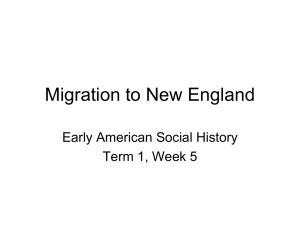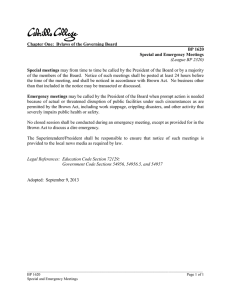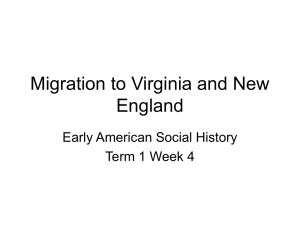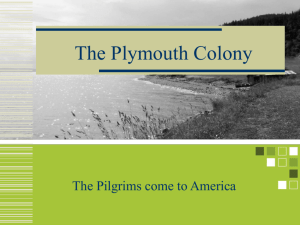Migration to New England Early American Social History Term 1, Week 5
advertisement
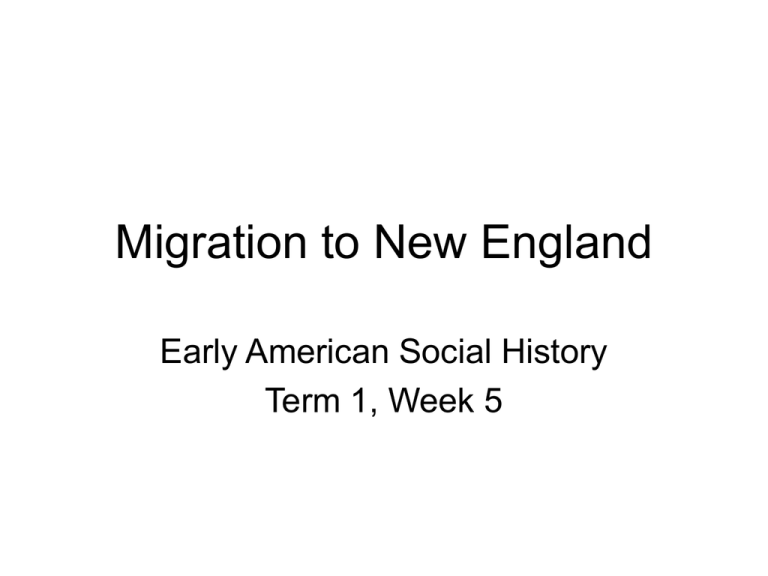
Migration to New England Early American Social History Term 1, Week 5 Introduction • New England important because of religious origins, tale of spiritual re-birth, attempt to create utopia • New England known to have harsher climate than Va • Marked differences between New England and earlier settlements in Va • 5 main areas of settlement in New England between 1620 and 1638. – – – – – Plymouth 1620 Massachusetts Bay 1630 Connecticut 1634 Rhode Island 1636 New Haven 1638. Pilgrims 1 • 1608 persecuted Eng separatists left Scrooby (Notts) for Holland (Leiden) seeking religious freedoms • 1620 same group fear resumption of Spanish/Dutch war, and think the Dutch too capitalist – seek to voyage to America. • Unable to get own charter, purchase land grant off Va Company (most = merchants, i.e. have money) Pilgrims 2 • Sept 1620, 102 settlers leave Plymouth on Mayflower, Nov 1620 sight Cape Cod, far north of original destination, but still within limits of Va Co. charter. • Move from Cape Cod to settlement they name Plymouth. • Not all settlers = separatists, but all join to sign Mayflower Compact, agreeing to work together for future of colony. • Gov William Bradford, good Indian relations with Massasoit, enables settlement to survive, though 50% die in first year. • 3 day feast of thanksgiving celebrated Nov 1621. Plymouth Plantation Plymouth Gov William Bradford Puritan Origins • 1630 new settlement led by John Winthrop (b.1588 to wealthy East Anglian family), of 700 non-separating congregationalists. • Most migrants from East Anglia, affected by decline in cloth trade, but also lacked strong deferential traditions, and radical protestant texts came into EA ports from Germany. • Disliked lingering Catholic practices in Anglicanism, eg vestments, Bishops etc. • Belief that separation of church and state was necessary ‘only the Godly should rule the Godly’ • Yet, committed to ideals of the C of E, therefore try to set example of behaviour for others to follow • Image = staid, boring, no fun – but really just trying not to be sinful. Puritans in England • Each congregation independent (hence name), chose own ministers etc. • Refuse to accept authority of bishops or any civil power over religion • Tolerated, rather than accepted, until appointment of William Laud as Abp of Canterbury (1620) – high church, emphasis on hierarchy, increased investigation and persecution of dissenters, e.g. ministers banned from pulpits, arrested etc Getting the charter • Va Co dead by 1624, new charter needed. • Puritan merchants get charter of Massachusetts Bay Company from King 1629 • Only migrants allowed to be shareholders, so charter taken to America – prevents alteration at later date. • 4 ships set out for America in 1630, the Arbella, the Talbot, the Ambrose and the Jewel. Settlers • Most migrants (70%) in family groups; 30% single males, but usually attached to families as servants. • Adults usually in 30s or 40s, brought children with them, had more after arrival. • Life exp v good, 70s when only 50s in Eng, few problems with disease, no major Indian problem (smallpox epidemic) Why go? • Seek religious freedoms – worship without interference • ‘To be as a city on a hill, the eyes of the world shall be upon us’ • Prove that religious utopia possible, and that it would be the best type of society. • Only persecution and econ hardship remaining in Eng – ec motives? John Winthrop Great Migration • 1620 - 1642 about 25,000 people migrated to New England in 198 ships, by 1640 total popn = 40,000. • Migration very low 1642-60, due to Civil War, picks up after 1660. • Unlike Chesapeake migration not ongoing phenomenon, society more settled stable • Whole communities transplanted across Atlantic, renamed new settlements after English ones eg Boston, Dedham, Springfield, Sudbury etc. • By 1636 Harvard founded in Cambridge, link to Emmanuel College – 90 New England ministers had been trained there.
